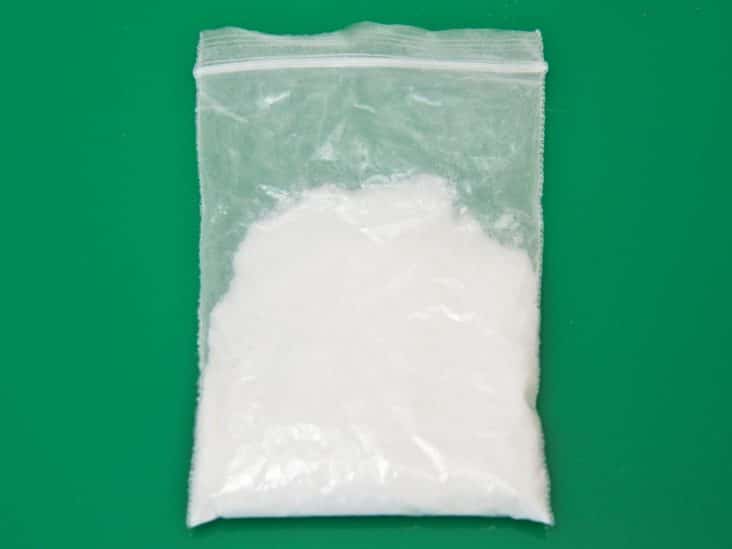What Does Fentanyl Look Like?

Medically Reviewed By: Kimberly Langdon, M.D.

The look of fentanyl can change depending on which form of the opioid drug is used. Fentanyl is both a prescription opioid as well as an illicit drug and appears in liquid, tablet, or powder form.
Fentanyl (brand names Actiq, Abstral, Duragesic, Fentora) is a synthetic opioid that belongs to the class of drugs known as narcotic (opiate) analgesics. It is a Schedule II controlled substance according to the Drug Enforcement Administration (DEA) and has a high potential for abuse.
Types Of Fentanyl
The Centers for Disease Control and Prevention (CDC) states there are two types of fentanyl, pharmaceutical fentanyl and illicitly manufactured fentanyl.
What Does Pharmaceutical Fentanyl Look Like?
In order to treat severe pain, your healthcare provider may prescribe you blue or white lozenges or tablets that contain fentanyl. These lozenges may be attached to the end of a handle.
In pharmaceutical form, fentanyl is offered as a variety of lozenges including tablets which can be taken underneath the tongue, a tablet taken between the gum and cheek, and a tablet to be swallowed.
Lozenges are contained in blister packaging. Depending on which lozenge you take, it may be necessary to consume the drug by licking it as if it were a lollipop. The tip of the medication is the color white.
Pharmaceutical fentanyl is also offered as films, also known as Onsolis. These prescription drugs must be taken out of the foil package and then placed firmly on the inside of your mouth.


What Does Illicitly Manufactured Fentanyl Look Like?
Illicitly manufactured fentanyl is available on the drug market in a number of forms. Fentanyl can be sold as:
- a powder
- liquid dropped on blotter paper
- eyes drops
- nasal sprays
- liquid added to small candies
Fentanyl in the form of counterfeit pills may be purchased on the drug market. Taking street drugs can be dangerous due to the fact they are not professionally made.
Fentanyl test strips are advised to be used before taking any drug use. These strips allow a person to determine if the street drug contains any traces of fentanyl.



Side Effects Of Fentanyl
Fentanyl can cause a number of serious side effects, ranging in severity.
Short-Term Side Effects
Some of the short-term side effects of fentanyl may include:
- drowsiness
- sedation
- feelings of euphoria
- sleepiness
- dry mouth
- mental health issues such as anxiety or depression
- unusual thinking
- changes in vision
Long-Term Side Effects
Long-term use of fentanyl can lead to a number of serious and life-threatening health problems including psychological or physical dependence. This can lead to serious withdrawal symptoms like intense drug cravings and sleep problems.
Those who abuse the drug long-term may develop a fentanyl addiction as well. Other long-term effects consist of breathing problems and confusion.
Dangers Of Illicitly Manufactured Fentanyl
There are a number of dangers associated with taking drugs on the illicit drug market.
Fentanyl-Laced Drugs
A number of drug interactions occur leading to life-threatening health problems including a fatal overdose. Fentanyl can be laced with other drugs when a person purchases this drug illegally. This has led to a large number of overdoses.
Serious reactions can take place when fentanyl is taken with other central nervous system (CNS) depressants.
Some of the following drugs may be laced with fentanyl without you knowing:
- benzodiazepines
- methamphetamine
- cannabis
- stimulants
- heroin
- cocaine
Specific prescription pills which may be counterfeit include alprazolam (Xanax), oxycodone (Percocet and Oxycontin or oxy in slang terms), and dextroamphetamine and amphetamine (Adderall).
Based on look alone, it can be difficult to tell if a counterfeit pill contains fentanyl. Using a fentanyl test strip is the only fool-proof measure to determine the contents of a counterfeit pill bought off the street.
Fentanyl Overdose
Those who take large amounts of fentanyl or abuse the drug in any manner may increase their risk of a fentanyl overdose.
Some of the symptoms of an opioid overdose include:
- limp body
- loss of consciousness
- choking noises
- blue lips or fingernails
- cold or clammy skin
- respiratory depression
The CDC states that a high number of drug overdose deaths occur when fentanyl is combined with CNS depressants such as benzodiazepines. When benzodiazepines are combined with fentanyl, a person may unknowingly take a lethal dose of fentanyl.
Naloxone (brand name Narcan) can be used to help reverse the effects of an overdose. If you suspect that yourself or a loved one is suffering from a drug overdose, contact 911 immediately.
For those of you struggling with substance use or fentanyl addiction, please contact Ohio Recovery Center to learn about our inpatient behavioral health care options.
- Centers for Disease Control and Prevention - Fentanyl https://www.cdc.gov/opioids/basics/fentanyl.html
- National Institute on Drug Abuse - What Is Fentanyl? https://nida.nih.gov/publications/drugfacts/fentanyl
- National Library of Medicine - Fentanyl https://medlineplus.gov/druginfo/meds/a605043.html
- United States Department of Health and Human Human Services - What Are Opioids? https://www.hhs.gov/opioids/prevention/index.html
- United States Drug Enforcement Administration - Fentanyl https://www.deadiversion.usdoj.gov/drug_chem_info/fentanyl.pdf
- United States Drug Enforcement Administration - List of Controlled Substances https://www.deadiversion.usdoj.gov/schedules/
- United States Food and Drug Administration - Opioid Medications https://www.fda.gov/drugs/information-drug-class/opioid-medications

